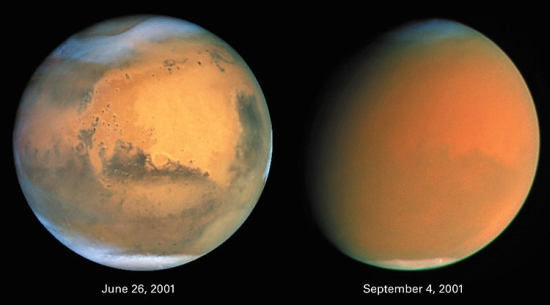¡SkyCaramba! Weekly astronomy blog for the week ending September 29, 2012

Mars has four seasons, just like Earth. Of course, we’re talking about very different weather on the red planet. There’s no rainy season or days we’d think of as hot. There are no trees with budding new leaves in the spring and colorful old leaves in the fall. However, someone on Mars watching the sky every day would observe the sun to be farther north in one season than in another. And the lengths of the days and nights would vary too.
Earth went through its southward equinox on September 22. Mars has its southward equinox on September 29th. Because Earth’s seasons and the world’s dominant calendar system are tied to the planet’s orbit, Earth’s seasons happen at the same time every year.
Exact times of specific events vary a little. Some equinoxes will happen on September 21. But people in the northern hemisphere think of September and October as autumn months.
Mars’s seasons last longer and we cannot impose our calendar on the red planet to quickly determine the seasons there. This time next year, Mars will be in the middle of a northern hemisphere spring.
A day on Mars is 39 minutes longer than on Earth and the Martian poles tilt toward or away from the sun about a degree and a half more than those of Earth. Those similarities to Earth contribute to Mars having seasons. But being farther from the sun, Mars gets less solar heating. And the red planet doesn’t have oceans to store heat in. So it stays colder than we’re used to there.
Mars does experience big temperature swings in that very cold range below our comfort level though. During one hemisphere’s summer, its polar ice cap shrinks. The ice cap in the other hemisphere grows. Those ice caps on Mars are made of frozen carbon dioxide.
Wind blows on Mars mostly due to temperature differences. As air warms, its molecules move farther apart from each other unless they are in an airtight container. The relatively warm air in one hemisphere moves toward colder air in the other. Since Martian air is so thin, the wind blows easily. Sometimes, the wind blows so fast there, it kicks up dust all over the planet! A dust storm there in 2001 kept astronomers from seeing anything on Mars’s surface for months.
When the dust settles, green surface areas on Mars may look brighter or duller than before. Astronomers used to think those were areas of vegetation growing up and dying off. It seems natural to want to believe there’s Earth-like life on other planets. Plants we know on Earth may grow well in so much carbon dioxide, but they’d have to tolerate the soil and temperatures hundreds of degrees below zero.
If you want to read more about seasons on Mars, here are some links to get you started. ¡SkyCaramba!
http://www.spacetoday.org/SolSys/Mars/MarsThePlanet/MarsDustStorms.html
http://planetary.org/explore/space-topics/mars/mars-calendar.html
http://www.msss.com/http/ps/seasons/seasons.html